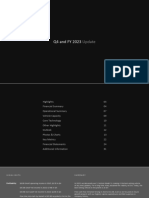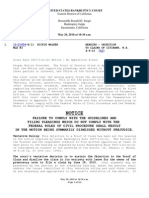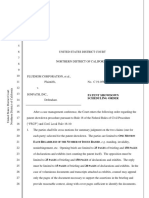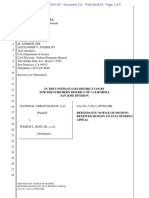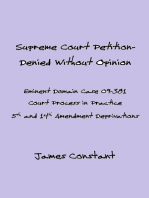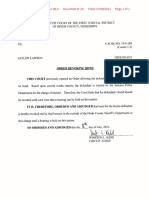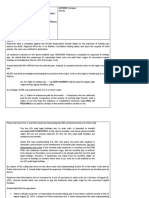Elon Musk Twitter SEC
Elon Musk Twitter SEC
Uploaded by
Simon AlvarezCopyright:
Available Formats
Elon Musk Twitter SEC
Elon Musk Twitter SEC
Uploaded by
Simon AlvarezOriginal Description:
Copyright
Available Formats
Share this document
Did you find this document useful?
Is this content inappropriate?
Copyright:
Available Formats
Elon Musk Twitter SEC
Elon Musk Twitter SEC
Uploaded by
Simon AlvarezCopyright:
Available Formats
Case 3:23-mc-80253-LB Document 37 Filed 02/10/24 Page 1 of 10
8 UNITED STATES DISTRICT COURT
9 NORTHERN DISTRICT OF CALIFORNIA
10 San Francisco Division
11 SECURITIES AND EXCHANGE Case No. 23-mc-80253-LB
COMMISSION,
12 ORDER COMPELLING
Northern District of California
Applicant, COMPLIANCE WITH
United States District Court
13 ADMINISTRATIVE SUBPOENA
v.
14 Re: ECF No. 1
ELON MUSK,
15
Respondent
16
17 INTRODUCTION
18 The SEC has applied for an order to compel compliance with its investigative subpoena for
19 respondent Elon Musk to appear and testify at the SEC’s San Francisco office about possible
20 violations of federal securities laws in connection with his 2022 purchase of Twitter and his
21 statements about that purchase. 1 The parties, at least initially, agreed to a date but ultimately the
22 respondent did not appear and resists the subpoena on the grounds that the SEC’s investigation is
23 baseless and harassing and seeks irrelevant information. Also, he contends that the subpoena —
24 issued by an SEC staff member appointed by the SEC’s Director of Enforcement — exceeds the
25
26
27
1
Appl. – ECF No. 1. Citations refer to material in the Electronic Case File (ECF); pinpoint citations
28 are to the ECF-generated page numbers at the top of documents.
ORDER – No. 23-mc-80253-LB
Case 3:23-mc-80253-LB Document 37 Filed 02/10/24 Page 2 of 10
1 SEC’s authority because it was not issued by an officer appointed by the President, a court, or the
2 head of a department, as required by the Appointments Clause of the U.S. Constitution.2
3 The court enforces the subpoena: the evidence is relevant and material to the SEC’s
4 investigation, and the testimony is not unduly burdensome. As to the argument that the subpoena
5 exceeds the SEC’s authority, the Exchange Act authorizes the subpoena, and the staff attorneys
6 who issue subpoenas are not inferior officers subject to the Appointments Clause.
7 The parties must confer within one week and settle on a date and location for the testimony.
9 STATEMENT
10 The SEC issued a formal order initiating its investigation on April 14, 2022, and it issued a
11 corrected order on July 15, 2023. The orders authorized SEC staff to investigate — including
12 through subpoenas for documents and testimony — whether persons may have violated the federal
Northern District of California
United States District Court
13 securities laws in connection with the respondent’s purchase of Twitter in 2022 and his 2022
14 statements and SEC filings relating to Twitter. 3 The SEC served the respondent with a subpoena
15 for his testimony, and he testified by videoconference in two half-day sessions on July 12 and 27,
16 2022. 4 Since then, the SEC has received “thousands of new documents” from various parties,
17 including hundreds of documents from the respondent. Nearly half of the respondent’s production
18 to the SEC occurred after his last half-day session, including documents that he authored. 5 The
19 SEC thus wants to ask the respondent about the new information. In April 2023, SEC staff
20 informed the respondent’s counsel that it would subpoena the respondent for in-person testimony
21 in San Francisco. The respondent’s counsel provided scheduling conflicts, and ultimately, on May
22 23, 2023, the respondent’s counsel agreed that the respondent would appear for investigative
23 testimony in San Francisco on September 14, 2023. He did not object to either to the testimony or
24 to an in-person appearance. Later that day, the SEC served the respondent with the subpoena
25
2
26 Opp’n – ECF No. 24 at 8–9.
3
Andrews Decl. – ECF No. 2 at 2–3 (¶¶ 2–3, 5).
27 4
Id. at 3 (¶ 6).
28 5
Id. (¶ 7).
ORDER – No. 23-mc-80253-LB 2
Case 3:23-mc-80253-LB Document 37 Filed 02/10/24 Page 3 of 10
1 requiring his attendance for testimony on September 14 at the SEC’s San Francisco office. 6 The
2 respondent did not object to the subpoena. 7
3 On August 28, 2023, the respondent’s counsel asked to move the testimony date from
4 September 14 to September 15, 2023, to accommodate the respondent’s travel schedule. The SEC
5 agreed to the accommodation and issued a second subpoena for the respondent’s appearance on
6 September 15. 8 On September 13, the respondent’s counsel informed the SEC that the respondent
7 would not appear on September 15 for several reasons: (1) it was not clear why the SEC needed to
8 question the respondent further, given the earlier testimony; (2) the in-person testimony in San
9 Francisco suggested bad faith because the respondent lives elsewhere; (3) a six-hundred-page
10 biography was published on September 12, and counsel needed to review it (and expected that the
11 SEC would want to review it too); and (4) these matters needed to be resolved before the
12 respondent provided further testimony. 9 The SEC responded the next day, explained that it needed
Northern District of California
United States District Court
13 another day of testimony to review new documents, summarized the parties’ discussions and
14 agreements for the respondent to provide testimony in September 2023, cited its statutory
15 authority to compel attendance at any place in the U.S., 15 U.S.C. § 78u(b), and offered two new
16 dates (September 19 and September 20) in San Francisco, citing media reports that the respondent
17 would be in the San Francisco area then. 10 The respondent did not appear on September 15. 11
18 Based on its understanding that the respondent lives in Austin, Texas, on September 19, the
19 SEC sent an email to the respondent’s counsel offering to conduct the testimony at the SEC’s
20 office in Fort Worth, Texas, on various dates in October. 12 On September 21, the SEC sent a
21 follow-up letter offering additional dates in November. 13 On September 24, 2023, the respondent’s
22
6
23 Id. at 3–4 (¶¶ 8–9); Subpoena, Ex. 2 to id. – ECF No. 2-2.
7
Andrews Decl. – ECF No. 2 at 4 (¶ 10).
24 8
Id. (¶ 11).
25 9
Id. (¶ 13); Letter, Ex. 4 to id. – ECF No. 2-4.
10
26 Letter, Ex. 5 to id. – ECF No. 2-5.
11
Andrews Decl. – ECF No. 2 at 4 (¶ 14).
27 12
Email, Ex. 6 to id. – ECF No. 2-6.
28 13
Letter, Ex. 7 to id. – ECF No. 2-7.
ORDER – No. 23-mc-80253-LB 3
Case 3:23-mc-80253-LB Document 37 Filed 02/10/24 Page 4 of 10
1 counsel sent a letter saying that that the respondent would not appear for several reasons: the SEC
2 had leaked information to the mainstream media, the investigation was frivolous (shown in part by
3 the SEC’s opening it the day after it closed an earlier investigation), and the litany of document
4 requests and demand for a third testimony — in the face of a multi-year investigation “arising
5 from the accidental tardiness of a clerical filing” — was troubling government action. 14 The SEC
6 responded on September 25, characterizing the objections as baseless and asking the respondent to
7 reconsider his refusal to provide testimony. 15 The respondent did not reply to the letter. 16
8 To support his contention of harassment, the respondent points to the SEC’s “unrelenting
9 investigation” of the respondent, including its two September 2018 actions against him in the
10 S.D.N.Y. for his statements on Twitter. 17 He characterizes the settlement of those cases as a forced
11 consent decree with First Amendment implications in the form of the requirement for a Tesla
12 lawyer’s preapproval of public communications “on a range of subject matters.” 18 He identifies
Northern District of California
United States District Court
13 the SEC’s loss of its contempt motion against the respondent for a tweet and the jury’s finding of
14 no liability in a private securities action. 19 Since 2018, the SEC has issued “dozens upon dozens”
15 of burdensome and costly subpoenas to the respondent and to his related entities without bringing
16 formal charges. 20 On November 18, 2019, the SEC closed its investigation into the 2018 tweet but
17 opened a new investigation into SpaceX. 21
18 The respondent characterizes the SEC’s actions as “dirty tactics:” For example, in connection
19 with the contempt action (discussed in the last paragraph), an SEC staff member leaked
20
21
14
22 Letter, Ex. 8 to id. – ECF No. 2-8.
15
Letter, Ex. 9 to id. – ECF No. 2-9.
23 16
Andrews Decl. – ECF No. 2 at 5 (¶ 18).
24 17
Opp’n – ECF No. 24 at 9 (citing SEC v. Musk, 1:18-cv-8865 (S.D.N.Y.), ECF No. 1; SEC v. Tesla,
1:18-cv-8947 (S.D.N.Y.)).
25 18
Id.
26 19
Id. at 9–10 (citing SEC v. Musk, 1:18-cv-8865, ECF Nos. 18, 39, 48, and In re Tesla Inc. Sec. Litig.,
No. 18-CV-04865-EMC, ECF No. 671 (N.D. Cal. Feb. 3, 2023)).
27 20
Spiro Decl. – ECF No. 25 at 3 (¶ 11).
28 21
Id. at 3 (¶ 12).
ORDER – No. 23-mc-80253-LB 4
Case 3:23-mc-80253-LB Document 37 Filed 02/10/24 Page 5 of 10
1 information to the press. 22 He also references the SEC’s hijacking of an investigation into the
2 respondent’s SEC Rule 13d-1 disclosures. 17 C.F.R. § 240.13d. On the same day that the
3 respondent disclosed his acquisition of Twitter stock on Schedule 13G (the form for passive
4 investors who acquire more than five percent of a publicly traded stock), the SEC’s Division of
5 Corporation Finance asked about the filing. 23 The next day the respondent filed a Schedule 13D
6 (the form for investors who are not passive investors). 24 Shortly thereafter, the Enforcement
7 Division intervened “so that the same individuals investigating Mr. Musk’s compliance with the
8 consent decree could also manage the present investigation.” 25 The SEC usually resolves untimely
9 filings with fines. 26 But here, it has issued thirty-two administrative subpoenas in the investigation,
10 including five document subpoenas — including for all of the respondent’s emails through August
11 2022 related to the Twitter merger — and three testimony subpoenas to the respondent. 27 It has
12 taken the respondent’s testimony twice for a total of eight hours, 28 the testimony of the
Northern District of California
United States District Court
13 respondent’s wealth manager three times for a total of twelve hours, 29 and testimony from at least
14 two other individuals. 30
15 The court held a hearing on December 14, 2023.
16
17
18
19
20 22
Opp’n – ECF No. 24 at 10 (citing SEC v. Musk, 1:18-cv-8865, ECF No. 71); Spiro Decl. – ECF No.
25 at 3 (¶ 13) (SEC has never denied that it was responsible for the leak).
21 23
Spiro Decl. – ECF No. 25 at 3 (¶ 14); Schedule 13G, Ex. 1 to id. – ECF No. 25-1.
22 24
Schedule 13D, Ex. 2 to id. – ECF No. 25-2.
25
23 Spiro Decl. – ECF No. 25 at 3 (¶ 14).
26
Opp’n – ECF No. 24 at 11–12 (citing specific cases, including one involving a $100,000 fine for a
24 hedge fund that failed to timely file a Schedule 13D for approximately 45 days after it previously filed a
Schedule 13G, and three other cases imposing fines of $100,000, $120,000, and $150,000 for — at least
25 for two cases — longer delays).
27
26 Spiro Decl. – ECF No. 25 at 3 (¶ 15).
28
Id. at 3–4 (¶¶ 17–18)
27 29
Id. (¶¶ 16, 19, 21).
28 30
Id. at 3 (¶ 15).
ORDER – No. 23-mc-80253-LB 5
Case 3:23-mc-80253-LB Document 37 Filed 02/10/24 Page 6 of 10
1 ANALYSIS
2 The respondent challenges the SEC subpoena as irrelevant and burdensome, and he also
3 contends that it exceeds the SEC’s authority because it was not issued by an officer appointed by
4 the President, a court, or the head of a department. 31 The court grants the SEC’s motion to enforce
5 the subpoena: it seeks relevant information, and it is otherwise valid.
7 1. The Subpoena Seeks Relevant Information
8 The court’s inquiry is narrow: the issues are (1) whether Congress has granted the authority to
9 investigate, (2) whether the procedural requirements have been followed, and (3) whether the
10 evidence is relevant and material to the investigation. SEC v. Obioha, No. 12-cv-80109-WHA,
11 2012 WL 4889286, at *1 (N.D. Cal. Oct. 12, 2012) (quoting EEOC v. Fed. Exp. Corp., 558 F.3d
12 842, 848 (9th Cir. 2009); see also United States v. Powell, 379 U.S. 48, 57–58 (1964)
Northern District of California
United States District Court
13 (administrative agency’s investigative subpoena (there, an IRS subpoena) must be enforced if its
14 investigation has a legitimate purpose, the information may be relevant to that purpose, the agency
15 does not already possess the information, and all administrative steps have been followed). “An
16 affidavit from a government official is sufficient to establish a sprima facie showing that these
17 requirements have been met.” FDIC v. Garner, 126 F.3d 1138, 1143 (9th Cir. 1997).
18 First, the SEC has broad authority to issue subpoenas. SEC v. Jerry T. O’Brien, Inc., 467 U.S.
19 735, 741 743 (1984) (“The provisions vesting the SEC with power to issue and seek enforcement
20 of subpoenas are expansive.”) Its authority includes the power to “subpoena witnesses, compel
21 their attendance, take evidence, and require the production of any books, papers, correspondence,
22 memoranda, or other records which the Commission deems relevant or material to the inquiry.” 15
23 U.S.C. § 78u(b); see also id. § 77t(a). The investigation here — about possible violations of the
24 federal securities laws in connection with the respondent’s 2022 purchases of Twitter stock and
25
26
27
28 31
Opp’n – ECF No. 24 at 8–9.
ORDER – No. 23-mc-80253-LB 6
Case 3:23-mc-80253-LB Document 37 Filed 02/10/24 Page 7 of 10
1 his 2022 statements and SEC filings relating to Twitter — were authorized by the SEC’s Formal
2 Orders. 32
3 Second, the information that the SEC seeks is relevant to that investigation. “For purposes of
4 subpoena enforcement, relevance of the evidence is established when the information sought is not
5 ‘plainly incompetent or irrelevant for any lawful purpose.’” Obioha, 2012 WL 4880286, at *1
6 (quoting Endicott Johnson Corp. v. Perkins, 317 U.S. 501, 408 (1943)). The respondent is the
7 person who made the securities purchases, statements, and SEC filings, and the SEC may question
8 him on those topics. This is an investigative subpoena. Minimal relevance is required to enforce it. 33
9 Third, the SEC does not have the information. It wants to question the respondent about new
10 information it received after his prior testimony. 34
11 Fourth, the SEC has satisfied all administrate prerequisites. The SEC can compel the attendance
12 of witnesses that it deems relevant or material to its investigation. 15 U.S.C. §§ 77s(c), 77u(b). It
Northern District of California
United States District Court
13 issued subpoenas for the testimony. The respondent did not comply with the subpoenas. 35
14 Because the SEC issued its subpoena lawfully, the burden shifts to the respondent to prove that
15 the subpoena was issued in bad faith or for an improper purpose, such as harassment or to pressure
16 that person to settle a collateral dispute, Powell, 379 U.S. at 58, or is “overbroad or unduly
17 burdensome,” EEOC v. Children’s Hosp. Med. Center, 719 F.3d 1426, 1428 (9th Cir. 1983). The
18 respondent has not met this burden. He did not object to the subpoenas initially and asked only for
19 an accommodation for his schedule. 36 Only later did he object to the testimony as irrelevant and
20 harassing, in part because he testified twice previously. 37 The SEC’s view is that the timing
21
22
23
24 32
See supra Statement.
25 33
Appl. – ECF No. 1 at 12–13 (collecting cases on this point).
34
26 See supra Statement.
35
See id.
27 36
See id.
28 37
See id.
ORDER – No. 23-mc-80253-LB 7
Case 3:23-mc-80253-LB Document 37 Filed 02/10/24 Page 8 of 10
1 suggests gamesmanship. 38 But in any event, the contemplated testimony is about productions that
2 post-dated his testimony.
3 The respondent also suggests that the SEC’s investigation is overkill, pointing to its hijacking
4 of the investigation into the respondent’s SEC Rule 13d-1 disclosures and contrasting its ordinary
5 practice of fines for Rule 13d violations with the extensive investigation here. 39 But the
6 investigation is about more than a late filing: there are eleven Section 13 filings from April to July
7 2022. Also, the SEC is investigating potential fraud in connection with securities transactions, in
8 violation of § 10(b) of the Exchange Act and Rule 10b-5, including the respondent’s public
9 statements about Twitter. 40
10 The other investigations are not demonstrably harassment: they are legitimate government
11 investigations. Cf. SEC v. Musk, No. 22-1291, 2023 WL 3451402, at *2 (2nd Cir. May 15, 2023)
12 (affirming district court’s denial of the respondent’s motion to terminate the 2018 SEC consent
Northern District of California
United States District Court
13 degree and rejecting claim of harassment).
14 Finally, whatever time the respondent’s counsel needed to review the biography was provided
15 by the SEC’s offer of new dates (and generally by the time that has passed), and any challenge to
16 the location of the deposition was addressed by the SEC’s offer to host the testimony in Texas. 41
17 In sum, the respondent’s claims of harassment generally are challenges to the relevancy of the
18 SEC’s continued investigation. But the SEC’s subpoena is within its authority, definite, and seeks
19 relevant information. The court grants the SEC’s application to enforce the subpoena.
20
21 2. The Subpoena Does Not Exceed the SEC’s Authority
22 The respondent contends that the subpoena — issued by an SEC staff member appointed by
23 the SEC’s Director of Enforcement — exceeds the SEC’s authority because it was not issued by
24
25
38
26 Reply – ECF No. 28 at 12.
39
See supra Statement.
27 40
Second Andrews Decl. – ECF No. 29 at 3–4 (¶¶ 6–9) (referencing the Formal Orders).
28 41
See supra Statement.
ORDER – No. 23-mc-80253-LB 8
Case 3:23-mc-80253-LB Document 37 Filed 02/10/24 Page 9 of 10
1 an officer appointed by the President, a court, or the head of a department, as required by the
2 Appointments Clause of the U.S. Constitution.42 U.S. Const. Art. II, § 2, Cl. 2.
3 The Exchange Act authorizes the SEC to investigate potential securities violations and allows
4 “any member of the Commission or any officer designated by it” to administer oaths, subpoena
5 witnesses and compel their attendance, take evidence, and require the production of any
6 documents or records that “the Commission deems relevant or material to the inquiry.” 15 U.S.C.
7 § 78u(b). The Commission has delegated the authority to “order the making” of investigations to
8 the Director of the Division of Enforcement. 17 C.F.R. § 200.30-4(a)(13); see also 15 U.S.C. §§
9 78d-1, 78d-2.
10 The respondent contends that the SEC Enforcement Staff who issue administrative subpoenas
11 in aid of enforcement investigations are inferior officers subject to the Appointments Clause
12 because they are exercising significant government authority that can be performed only by
Northern District of California
United States District Court
13 officers appointed pursuant to the Appointments Clause. 43 And because they were not appointed
14 by the President, the Courts of Law, or the Heads of Departments, as required by U.S. Const. Art.
15 II, § 2, Cl. 2, and instead were appointed by the Director of the SEC Division of Enforcement, the
16 subpoenas are improper. 44
17 But as the SEC counters, the staff attorneys who sign subpoenas are non-officer employees not
18 subject to the Appointments Clause: they lack the “extensive powers . . . comparable to [] a federal
19 district judge conducting a bench trial.” 45 Lucia v. SEC, 138 S. Ct. 2044, 2049, 2053–3055 (2018)
20 (cleaned up) (holding that ALJs and special trial judges of the U.S. Tax Court are constitutional
21 officers). Instead, the attorneys are performing investigative functions pursuant to the SEC’s formal
22 orders. Moreover, as this case shows, the SEC cannot compel compliance with its subpoenas: it
23 needs a court order. They are not like the ALJs in Lucia. Cf. id. at 2051 (constitutional officers
24 “exercise significant authority pursuant to the laws of the United States”).
25
42
26 Opp’n – ECF No. 24 at 8–9, 23–29.
43
Id. at 24–25.
27 44
Id. at 26–27.
28 45
Reply – ECF No. 28 at 14.
ORDER – No. 23-mc-80253-LB 9
Case 3:23-mc-80253-LB Document 37 Filed 02/10/24 Page 10 of 10
1 Based on this conclusion, the court denies the respondent’s request to stay the case pending the
2 Supreme Court’s decision in Jarkesky v. SEC, 34 F.4th 446 (5th Cir. 2022), cert. granted, 143 S.
3 Ct. 2688 (2023). 46 It is unlikely to affect the outcome here.
5 CONCLUSION
6 The court grants the SEC’s application to enforce the subpoena. The parties must confer within
7 one week and settle on a date and location for the testimony. If they cannot agree, then they may
8 submit a joint letter brief with their respective positions, see Standing Order (attached) (discovery-
9 dispute procedures), and the court will decide the dispute for them.
10 This resolves ECF No. 1.
11 IT IS SO ORDERED.
12 Dated: February 10, 2024
Northern District of California
United States District Court
13 ______________________________________
LAUREL BEELER
14 United States Magistrate Judge
15
16
17
18
19
20
21
22
23
24
25
26
27
28 46
Opp’n – ECF No. 24 at 29–30; Reply – ECF No. 28 at 18.
ORDER – No. 23-mc-80253-LB 10
You might also like
- SEC Seeks SanctionsDocument17 pagesSEC Seeks SanctionsCNBC.comNo ratings yet
- TSLA Q4 2023 UpdateDocument32 pagesTSLA Q4 2023 UpdateSimon AlvarezNo ratings yet
- Rivian InvestorDayDocument121 pagesRivian InvestorDaySimon Alvarez100% (1)
- Gov Uscourts Delch 2018-0408-KSJM 354 0Document53 pagesGov Uscourts Delch 2018-0408-KSJM 354 0Simon AlvarezNo ratings yet
- 2023 Tesla Impact Report HighlightsDocument38 pages2023 Tesla Impact Report HighlightsSimon Alvarez100% (3)
- 2023 Tesla Impact ReportDocument160 pages2023 Tesla Impact ReportSimon AlvarezNo ratings yet
- Muthana File 2Document27 pagesMuthana File 2the kingfishNo ratings yet
- Respondent in Pro PerDocument41 pagesRespondent in Pro PerRebeca Mingura100% (1)
- Motion DeniedDocument3 pagesMotion DeniedMcKenzie StaufferNo ratings yet
- Motion For Reconsideration - Scott Dozier CaseDocument5 pagesMotion For Reconsideration - Scott Dozier CaseMichelle RindelsNo ratings yet
- J. Electrochem. Soc. 2019 Harlow A3031 44Document14 pagesJ. Electrochem. Soc. 2019 Harlow A3031 44Fred Lamert100% (12)
- SEC vs. Elon Musk - Order To Comply With SubpoenaDocument10 pagesSEC vs. Elon Musk - Order To Comply With SubpoenaCNBC.comNo ratings yet
- Notice of Reference and Order Setting Hearing On Plaintiffs' Document Requests (Docket No. 325)Document2 pagesNotice of Reference and Order Setting Hearing On Plaintiffs' Document Requests (Docket No. 325)Equality Case FilesNo ratings yet
- Order Denying Motions To Seal by Judge AlsupDocument3 pagesOrder Denying Motions To Seal by Judge AlsupMike SwiftNo ratings yet
- Joint Statement Regarding Respondent's Failure To Appear For Court-Ordered TestimonyDocument5 pagesJoint Statement Regarding Respondent's Failure To Appear For Court-Ordered TestimonySP-TechCrunchNo ratings yet
- Notice of Reference and Order Setting Hearing On Defendant-Intervenors Motion To Compel Compliance With Nonparty Document Subpoenas (Docket No. 472)Document2 pagesNotice of Reference and Order Setting Hearing On Defendant-Intervenors Motion To Compel Compliance With Nonparty Document Subpoenas (Docket No. 472)Equality Case FilesNo ratings yet
- Soufer Family LLC v. SpragueDocument6 pagesSoufer Family LLC v. SpragueVORTEX BORENo ratings yet
- OOO Brunswick v. Sultanov (Ex Parte Seizure Order - DTSA)Document8 pagesOOO Brunswick v. Sultanov (Ex Parte Seizure Order - DTSA)Ken VankoNo ratings yet
- 18-12-13 Order Denying Qualcomm's Request Re. Post-Discovery EventsDocument10 pages18-12-13 Order Denying Qualcomm's Request Re. Post-Discovery EventsFlorian MuellerNo ratings yet
- MOTION To Dismiss Indictment, Based On The Presidential Records Act by Donald J. Trump Exhibit 1Document148 pagesMOTION To Dismiss Indictment, Based On The Presidential Records Act by Donald J. Trump Exhibit 1Robert GouveiaNo ratings yet
- McEwen Default JudgmentDocument4 pagesMcEwen Default Judgmentche3282No ratings yet
- Doc.055 Order Resolving Dkts 51 and 53Document3 pagesDoc.055 Order Resolving Dkts 51 and 53zdppqm9sdnNo ratings yet
- Muthana FileDocument19 pagesMuthana Filethe kingfishNo ratings yet
- Kelleys OrderDocument7 pagesKelleys OrderrobbinscmNo ratings yet
- Hugheslj@Sec - Gov: 8:21-Cv-00403-Jvs-AdsxDocument5 pagesHugheslj@Sec - Gov: 8:21-Cv-00403-Jvs-Adsxtriguy_2010No ratings yet
- In Re WalkerDocument28 pagesIn Re Walkerzulu333No ratings yet
- Patent Showdown Scheduling Order: NE Otion ACH Egardless of The Umber of Ssues Aised Pages PagesDocument2 pagesPatent Showdown Scheduling Order: NE Otion ACH Egardless of The Umber of Ssues Aised Pages PagesabdNo ratings yet
- Order Denying Summary Judgment and Order To Show CaseDocument3 pagesOrder Denying Summary Judgment and Order To Show Casewww.righthavenlawsuits.comNo ratings yet
- Motion To Vacate Dismissal4.19.2012Document5 pagesMotion To Vacate Dismissal4.19.2012Valerie LopezNo ratings yet
- Nyag V Trump 060923 Mol Trial DelayDocument21 pagesNyag V Trump 060923 Mol Trial DelayBrett MeiselasNo ratings yet
- Essler@usdoj - Gov: Defendant'S Opposition To Plaintiff'S Ex Parte Application For Order Shortening TimeDocument6 pagesEssler@usdoj - Gov: Defendant'S Opposition To Plaintiff'S Ex Parte Application For Order Shortening TimeEquality Case FilesNo ratings yet
- Motion To Enforce JudgmentDocument9 pagesMotion To Enforce JudgmentKenan FarrellNo ratings yet
- Update To The Court - County Attorney's OfficeDocument5 pagesUpdate To The Court - County Attorney's OfficeNBC MontanaNo ratings yet
- CME0003Document4 pagesCME0003KyriesunsetNo ratings yet
- Jeffrey Clark V DC BAR Ethics Board Notice of 3rd RemovalDocument34 pagesJeffrey Clark V DC BAR Ethics Board Notice of 3rd RemovalFile 411No ratings yet
- Xped v. Exhibit 1 2022-01-20 TranscriptDocument25 pagesXped v. Exhibit 1 2022-01-20 TranscriptsqfreakNo ratings yet
- Tro Motion For A New TrialDocument38 pagesTro Motion For A New Trialmatt bakesNo ratings yet
- Anthony Preliminary InjunctionDocument33 pagesAnthony Preliminary InjunctionLas Vegas Review-JournalNo ratings yet
- FORECLOSURE HOME PURCHASER IGNORED A LIS PENDANS AND NOW TRIES TO STEAL HOME INSIDE OF A COURT OF LAW - Opposition To Motion To Annul StayDocument86 pagesFORECLOSURE HOME PURCHASER IGNORED A LIS PENDANS AND NOW TRIES TO STEAL HOME INSIDE OF A COURT OF LAW - Opposition To Motion To Annul Stay83jjmackNo ratings yet
- Will The Court Allow Fraudulent Documents To Prevail?? Opposition To Motion To Annul Stay - See Supporting Declaration As WellDocument25 pagesWill The Court Allow Fraudulent Documents To Prevail?? Opposition To Motion To Annul Stay - See Supporting Declaration As WellBlaqRubiNo ratings yet
- Https Ecf Casd Uscourts Gov Doc1 037116168501Document7 pagesHttps Ecf Casd Uscourts Gov Doc1 037116168501cb0bNo ratings yet
- 01.19.2018 Ezor Order Granting MTDDocument17 pages01.19.2018 Ezor Order Granting MTDKrista MarshallNo ratings yet
- 18-02-07 Order Setting Aside Sanctions OrderDocument3 pages18-02-07 Order Setting Aside Sanctions OrderFlorian MuellerNo ratings yet
- Abeel ORDER TO SHOW CAUSEDocument2 pagesAbeel ORDER TO SHOW CAUSEBobNo ratings yet
- Motion For Status ConferenceDocument12 pagesMotion For Status ConferenceJordan ConradsonNo ratings yet
- Aguirre Suit vs. NRCDocument21 pagesAguirre Suit vs. NRCRob NikolewskiNo ratings yet
- Doc.040-3 Ex 3 Order Re Discovery and Amended PODocument5 pagesDoc.040-3 Ex 3 Order Re Discovery and Amended POzdppqm9sdnNo ratings yet
- Anthony Motion For Preliminary InjunctionDocument33 pagesAnthony Motion For Preliminary InjunctionKristyn LeonardNo ratings yet
- Caso ToledoDocument2 pagesCaso ToledoDiario El ComercioNo ratings yet
- Motion To Recuse Judge Engoron Andrew Bailey AffirmationDocument6 pagesMotion To Recuse Judge Engoron Andrew Bailey AffirmationRobert GouveiaNo ratings yet
- Melendres #1921 - Arpaio Reply Re Recusal & DiscoveryDocument9 pagesMelendres #1921 - Arpaio Reply Re Recusal & DiscoveryJack RyanNo ratings yet
- Thacker Pass RulingDocument49 pagesThacker Pass RulingSteve SebeliusNo ratings yet
- 24 Aug 20-35739 Timeline OrderDocument3 pages24 Aug 20-35739 Timeline OrderRaindrop WorksNo ratings yet
- VOL. 328, MARCH 17, 2000 447: Sycip, Jr. vs. Court of AppealsDocument16 pagesVOL. 328, MARCH 17, 2000 447: Sycip, Jr. vs. Court of AppealsMirzi Olga Breech SilangNo ratings yet
- Saunders v. Egriu Brief On AppealDocument15 pagesSaunders v. Egriu Brief On AppealJim OstrowskiNo ratings yet
- Summary Order: Plaintiff-AppellantDocument4 pagesSummary Order: Plaintiff-AppellantJeffrey MalkanNo ratings yet
- ATF Attempts To Silence Gun Owners of America, 28 Opposition To MPODocument23 pagesATF Attempts To Silence Gun Owners of America, 28 Opposition To MPOAmmoLand Shooting Sports NewsNo ratings yet
- Motion To StayDocument8 pagesMotion To Staycronkitenews50% (2)
- Ruling On Expert Report in Nano Class ActionDocument8 pagesRuling On Expert Report in Nano Class Actionjeff_roberts881No ratings yet
- Los Abogados de Levidow: Sanción Por Mal Uso de ChatGPTDocument43 pagesLos Abogados de Levidow: Sanción Por Mal Uso de ChatGPTDialogo con la JurisprudenciaNo ratings yet
- Resolution Trust Corporation v. North Bridge Associates, Inc., 22 F.3d 1198, 1st Cir. (1994)Document15 pagesResolution Trust Corporation v. North Bridge Associates, Inc., 22 F.3d 1198, 1st Cir. (1994)Scribd Government DocsNo ratings yet
- Final Statement of Charges Against David Ruzumna (Case No. 11424) King County JudgeDocument3 pagesFinal Statement of Charges Against David Ruzumna (Case No. 11424) King County JudgeStandUpSisterNo ratings yet
- Petition for Certiorari Denied Without Opinion: Patent Case 98-1151From EverandPetition for Certiorari Denied Without Opinion: Patent Case 98-1151No ratings yet
- Supreme Court Eminent Domain Case 09-381 Denied Without OpinionFrom EverandSupreme Court Eminent Domain Case 09-381 Denied Without OpinionNo ratings yet
- Petition for Certiorari Denied Without Opinion: Patent Case 96-1178From EverandPetition for Certiorari Denied Without Opinion: Patent Case 96-1178No ratings yet
- Gov Uscourts Delch 2018-0408-KSJM 353 0Document5 pagesGov Uscourts Delch 2018-0408-KSJM 353 0Simon AlvarezNo ratings yet
- Hazeltree May Shortside Report - FinalDocument7 pagesHazeltree May Shortside Report - FinalSimon AlvarezNo ratings yet
- TSLA Q1 2024 UpdateDocument31 pagesTSLA Q1 2024 UpdateSimon AlvarezNo ratings yet
- Gov Uscourts Delch 2018-0408-KSJM 377 0Document4 pagesGov Uscourts Delch 2018-0408-KSJM 377 0Simon Alvarez100% (1)
- Tesla Proxy Statement 2024Document441 pagesTesla Proxy Statement 2024Simon AlvarezNo ratings yet
- Neuralink PRIME Study BrochureDocument2 pagesNeuralink PRIME Study BrochureSimon AlvarezNo ratings yet
- Starlink Cellular Service LaunchDocument23 pagesStarlink Cellular Service LaunchSimon AlvarezNo ratings yet
- General Assembly: Raised Bill No. 343Document10 pagesGeneral Assembly: Raised Bill No. 343Simon AlvarezNo ratings yet
- Stanford University Life Cycle Comparison of Industrial-Scale Lithium-Ion Battery Recycling and Mining Supply ChainsDocument63 pagesStanford University Life Cycle Comparison of Industrial-Scale Lithium-Ion Battery Recycling and Mining Supply ChainsSimon AlvarezNo ratings yet
- Tesla China New Year ReportDocument9 pagesTesla China New Year ReportSimon AlvarezNo ratings yet
- Neuralink PRIME Study BrochureDocument2 pagesNeuralink PRIME Study BrochureSimon AlvarezNo ratings yet
- Final CID To Media MattersDocument7 pagesFinal CID To Media MattersSimon AlvarezNo ratings yet
- Elon Musk 2018 Comp Plan Delaware Court DecisionDocument201 pagesElon Musk 2018 Comp Plan Delaware Court DecisionSimon AlvarezNo ratings yet
- Taycan Technical Spec SheetDocument1 pageTaycan Technical Spec SheetSimon AlvarezNo ratings yet
- Cruise Pedestrian Accident Quinn Emanuel ReportDocument195 pagesCruise Pedestrian Accident Quinn Emanuel ReportSimon AlvarezNo ratings yet
- Tesla Model 3 Safety Claims - ResponseDocument3 pagesTesla Model 3 Safety Claims - ResponseSimon AlvarezNo ratings yet
- Tesla Electromagnetic Windshield Wiper SystemDocument11 pagesTesla Electromagnetic Windshield Wiper SystemSimon AlvarezNo ratings yet
- Walmart Inc V Tesla Energy Operations Inc Exhibit S 55Document18 pagesWalmart Inc V Tesla Energy Operations Inc Exhibit S 55Simon AlvarezNo ratings yet
- Tesla Model 3 Safety Claims - NHTSA Cease and Desist LetterDocument3 pagesTesla Model 3 Safety Claims - NHTSA Cease and Desist LetterSimon AlvarezNo ratings yet
- Tesla Model 3 Crash Test. ReportDocument8 pagesTesla Model 3 Crash Test. ReportFred LamertNo ratings yet
- Topic 11 Burden and Degree of ProofDocument7 pagesTopic 11 Burden and Degree of ProofAisyah SyuhadaNo ratings yet
- Digests Feb 12Document58 pagesDigests Feb 12Ailyn AñanoNo ratings yet
- Protection of Well-Known Marks: Developments in The UK and India.Document10 pagesProtection of Well-Known Marks: Developments in The UK and India.Nikhil RanjanNo ratings yet
- Jaylon Lawson FileDocument7 pagesJaylon Lawson Filethe kingfishNo ratings yet
- Casemine From SujataDocument704 pagesCasemine From SujataYashwant Shripad BhaveNo ratings yet
- David V AgbayDocument3 pagesDavid V AgbayCourtney Tirol100% (1)
- Republic Vs Sagun (Full Text)Document3 pagesRepublic Vs Sagun (Full Text)Esnani MaiNo ratings yet
- Complaint SampleDocument6 pagesComplaint SampleAiza CabenianNo ratings yet
- Inguillo Vs First Phil ScalesDocument1 pageInguillo Vs First Phil ScalesGelyn DiazNo ratings yet
- Petitioners Vs Vs Respondent: First DivisionDocument8 pagesPetitioners Vs Vs Respondent: First DivisionHazel FernandezNo ratings yet
- Iis MicroprojectDocument12 pagesIis MicroprojectMeet PatelNo ratings yet
- Legal Forms - Defendant Pre-Trial BriefDocument4 pagesLegal Forms - Defendant Pre-Trial BriefIra100% (1)
- Legal Research Process NotesDocument3 pagesLegal Research Process NotesRyan Jhay YangNo ratings yet
- Mediator Opening Statement: 1. ConfidentialityDocument4 pagesMediator Opening Statement: 1. ConfidentialityAnurag SinghNo ratings yet
- Benjamin N CardozoDocument17 pagesBenjamin N CardozoSwati KishoreNo ratings yet
- Schools Can Collect Fee SC - 01-Oct-2021Document7 pagesSchools Can Collect Fee SC - 01-Oct-2021Ranga ReddyNo ratings yet
- Philippine Trust Company vs. Gabinete, G.R. No. 216120Document12 pagesPhilippine Trust Company vs. Gabinete, G.R. No. 216120Bok MalaNo ratings yet
- Public Interest Litigation and Its PitfallsDocument60 pagesPublic Interest Litigation and Its PitfallsAnonymous tOgAKZ8No ratings yet
- McMillan OAH AppealDocument7 pagesMcMillan OAH AppealAlex KomaNo ratings yet
- PSI Facility - CordesDocument2 pagesPSI Facility - CordesMichael EvermanNo ratings yet
- I and M Bank Ltd... Appli VS National Bank Tanzania..respondent Misc. Comm Appl No.2 of 2015 Rulig Hon - SongorojDocument5 pagesI and M Bank Ltd... Appli VS National Bank Tanzania..respondent Misc. Comm Appl No.2 of 2015 Rulig Hon - Songoroji.pmanaseNo ratings yet
- The Fruit of The Poisonous Tree Revisited and Shepardized PDFDocument74 pagesThe Fruit of The Poisonous Tree Revisited and Shepardized PDFAdv Girish Maniyedath100% (1)
- What Is A Pil?Document1 pageWhat Is A Pil?Dhivya RamachandranNo ratings yet
- Famous Judgements in PatentsDocument3 pagesFamous Judgements in PatentsDevvrat garhwalNo ratings yet
- G.R. No. 179961Document13 pagesG.R. No. 179961Cristelle Elaine ColleraNo ratings yet
- Company Law Chapter 1, 2 and 3 - Cs Neha Laddha - UnacademyDocument32 pagesCompany Law Chapter 1, 2 and 3 - Cs Neha Laddha - Unacademynavya singhNo ratings yet
- 08 Insular Bank of Asia and America Employee's Union V Incion (Enriquez)Document4 pages08 Insular Bank of Asia and America Employee's Union V Incion (Enriquez)Mikhel BeltranNo ratings yet
- Libre ComplaintDocument84 pagesLibre ComplaintGus BovaNo ratings yet
- DPC - VIth - Sem - 190101127 - Sanket KhandelwalDocument16 pagesDPC - VIth - Sem - 190101127 - Sanket KhandelwalSanketNo ratings yet
- Indice - The Art of Advocacy in International ArbitrationDocument6 pagesIndice - The Art of Advocacy in International ArbitrationolamasikikasdjNo ratings yet

